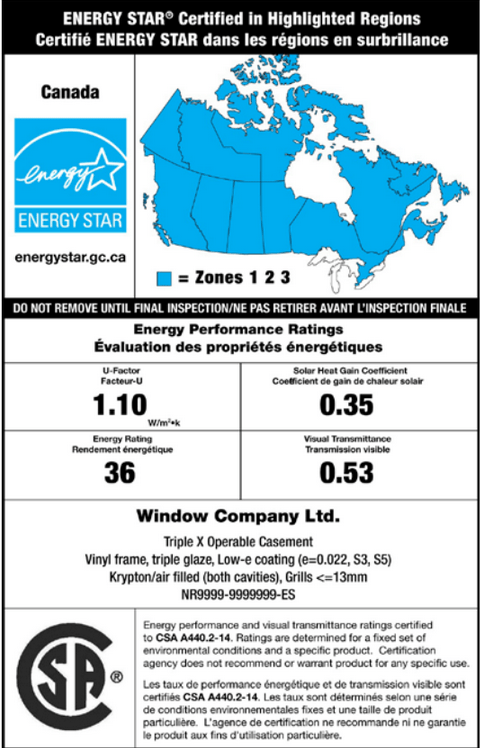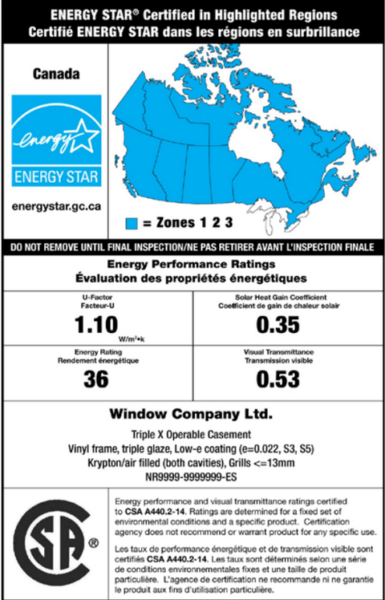Labeling plays an important role in the window manufacturing industry. On one hand, it protects you as a customer because it ensures you get what you pay for. On the other, it ensures that your windows meet specific certifications of quality required in our country.
Currently, all modern windows in Canada must adhere to the CSA-A440 standard. The Canadian Standards Association has laid out specific guidelines for window performance in three categories: air tightness, water tightness, and wind resistance.
Another important rating system used in labeling custom windows and doors is the Energy Star® program. The Energy Star is an internationally recognized symbol that requires specific information about your windows to appear on the label. In essence, it is based on the ER (Energy Rating) number of the window. In itself, the ER utilizes a number of ways of quantifying a window’s performance. We’ll focus on what they are in the second part of this post. Energy Star ratings for windows can be found on this Natural Resources Canada page.
In the recent years, Canadian windows manufacturers began to move toward labeling and certifying their product through the NAFS (North American Fenestration Standard). The NAFS is a system that allows for measuring and comparing Canadian and American windows. In Canada, NAFS is used alongside CSA – A440.
You can see both CSA and NAFS ratings for energy efficient windows on the the CSA Certified Product Listing Page
There are several unique factors about the NAFS system that differentiate it from existing ways of qualifying windows.
- A window is ranked according to Category Performance (CP) ranging from CP15 to CP100 (the higher the number, the more efficient the product is).
- Canada retains the same way to express air performance (A1 to A3).
- The B1 to B7 rating to express water infiltration resistance is abandoned. Now, the minimum pressure test expressed in Pa is used to deal with water infiltration.
- The C1 to C5 structural test rating is replaced by the positive and negative design pressure calculation also expressed in Pa.
- How the windows and doors will be used is taken into consideration (Categories: R-LC-CW-AW)
i. R for residential
ii. LC for light commercial (condominium three storeys and up)
iii. CW for commercial (schools, hospitals, etc.)
iv. AW for heavy duty commercial - Geographical requirements are taken into consideration
i. Open terrain: in a field, near a lake, etc.
ii.Closed terrain: in the city, protected by other buildings or trees, etc. - It requires windows companies to state the size of the window used for testing. Assemblies will also need to be tested separately.
- Under NAFS standards, it is not permitted to certify a window that is larger than the one tested. Currently, we can certify a window up to 25% larger than the test.
As per the NAFS requirements, new windows are being labeled in accordance with the NAFS standard. Any window or door that is compliant will have a label on it stating that the product design has been tested to NAFS‐08. These labels indicate four performance requirements:
- Performance Grade (PG)
- Design pressure (DP),
- Water penetration resistance test pressure (water pressure)
- Air infiltration/exfiltration
If the air infiltration/exfiltration meets NAFS‐08 minimum requirements then it also meets building code minimum anywhere in Canada. The PG, DP, and pressure requirements values vary by location across the country.
Supplement to the NAFS‐08 includes calculations to determine the performance requirement in 679 specific locations across Canada. These calculations can be complicated, so the Fenestration Canada set up a specific calculator on their website www.fenestrationcanada.ca.
For Edmonton and Calgary windows; the industry in Alberta does not follow NAFS guidelines yet. However, if your windows are manufactured out of the province, the production line may already be using NAFS compliant labeling.
The sample below shows all the information that is included on the new Energy Star Fenestration label. We will discuss how NAFS affects the Energy Star ratings, and what that means to Canadian window customers, in the next post.
Learn more about getting replacement windows:
Find out how much new windows should cost
Read about the importance of correct window installation
See some questions you should ask at your quote appointment


